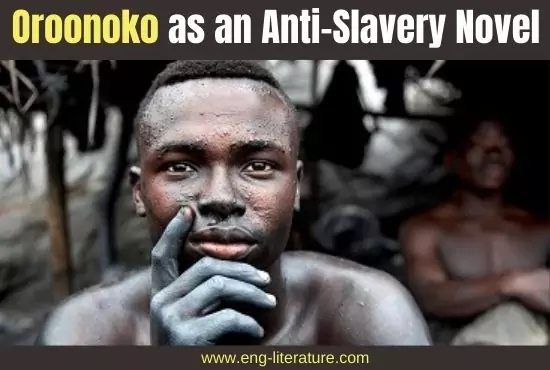Oroonoko as an Anti-Slavery Novel
Aphra Behn composed the novel Oroonoko in 1688 and based on her trip Surinam. The colony of Surinam began importing slaves in the 1950s, since there were not enough indentured servants coming from England for the labour-intensive sugar cane production. In 1662, the Duke of York got a commission to supply 3,000 slaves to the Caribbean, and Lord Willoughby was also a slave trader. For the most part, English slavers dealt with slave-takers in Africa and rarely captured slaves themselves. The story of Oroonoko’s abduction is plausible, for such raids did take place, but English slave traders avoided them where possible for fear of accidentally capturing a person who would anger the friendly groups on the coast. Most of the slaves came from the Gold Coast, and in particular from modern-day Ghana.
Oroonoko is often interpreted as an anti-slavery novel because of the way the narrator describes the struggle and injustices of a Coromantin slave from the Gold Coast, what is present-day Ghana. Behn’s work is highly contradictory in the sense that although she breaks the Aristotelian models of writing fiction, she promotes Aristotle’s idea of hierarchy in defense of an absolute monarchy. Oroonoko as a whole shows Behn’s contradictory stance on what is legitimate authority.
In 1649, England’s King Charles I was captured and beheaded because of his resistance to instituting a constitutional monarchy After his death, several theories about the need of a centralized government came into play, including Hobbes Leviathan written in 1651. In 1660, the monarchy in England was restored Behn lived through what has been called the most conflict-ridden period in British history. During this time, there were major debates on the British government should be structured.
Aristotle believed that equality in polities is illogical because society exists by nature like a family and therefore must have hierarchy. In Aphra Behn’s novel, she profoundly rejects the idea of democratic society. For example, when Prince Oroonoko is amongst the slaves, dawning the same clothing as them, he is still treated like a figure of authority:
Behn is illustrating to her reader that people with authority are given the power to rule even when dressed like a person with no authority. This is a rejection of democratic society, where authority is given to everyone equally. Behn’s novel blatantly promotes the idea of an absolute monarchy. She refers to “the deplorable death of our great monarch”. Through the character, Oroonoko, she shows that some people are meant to be in power.
Also Read:
- Problem of Racism in Aphra Behn’s Novel Oroonoko
- Concept of Gender Reversals in Oroonoko by Aphra Behn
- Oroonoko Book Review or The Royal Slave
Behn consciously separates Oroonoko from the other slaves in his character description. She shows an obvious stigma against the other slaves and their races, yet, Oroonoko is described in a way that makes him powerful and unique compared to the others:
“His face was not of that brown rusty black which most of that nation are, but perfect ebony, polished jet… His nose was rising and Roman, instead of African and flat. His mouth the finest shaped that could be seen; far from those great turned lips which are so natural to the rest of the negroes. The whole proportion and air of his face was so nobly and exactly formed that, bating his color, there could be nothing in nature more beautiful, agreeable and handsome.”
Behn describes Oroonoko as completely Roman, except for his skin color. He represents a figure of authority, one that despite his race will have power over others. Similarly, his slave name alludes to a reincarnation of all that is Rome, the model of civilization.
Although Behn seems to have sympathy for slaves, she only has sympathy for those that are noble like Oroonoko. This shows that Behn must have contradicting ideals like her novel. Later, Cesear defends the conditions that the slaves live in:
“…we are bought and sold like apes or monkeys, to be the sport of women, fools and cowards, and the support of rogues and runagates, that have abandoned their own countries for rapine, murders, theft, and villainies. And shall we render obedience to such a degenerate race, who have no human virtue left, to distinguish them from the vilest of creatures?”
In this time period, the Coromanti people were not uncivilized barbarians like the Africans described in Heart of Darkness by Joseph Conrad. The Coromanti people were multilingual, involved in trade, and far from primitive. They were not colonized or overtaken. Rather, slaves from the Gold Coast (present-day Ghana) were only obtained through war.
If this were an anti-slavery narrative, Aphra Behn should have ended it with the death of slavery. Instead, she concludes her novel with the graphic death of Oroonoko:
“They cut Caesar in quarters, and sent them to… the governor himself, that those of Caesar, on his plantations, and that he could govern his negroes without terrifying and grieving them with frightful spectacles of a mangled king”.
Although the governor learns to rid of the distressing conditions of the slaves’ lives, he does not agree to rid of slavery entirely.
To conclude, Behn’s novel is highly contradictory and has themes of obtaining an absolute monarchy contrasted with a sympathetic view on Oroonoko, a noble slave. Her novel is neither pro nor anti-slavery as some suggest. It is simply a historical narrative meant to capture the complications of societal structures.

Hello, Viewers! Besides being the Founder and Owner of this website, I am a Government Officer. As a hardcore literary lover, I am pursuing my dream by writing notes and articles related to Literature. Drop me a line anytime, whether it’s about any queries or demands or just to share your well-being. I’d love to hear from you. Thanks for stopping by!
